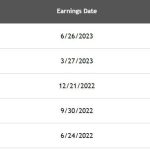Walgreens stock (NYSE: WBA) currently trades at $22 per share, nearly 60% below the level seen in March 2021, and it appears undervalued. WBA stock was trading at around $38 in early June 2022, just before the Fed started increasing rates, and is now 40% below that level, compared to 18% gains for the S&P 500 during this period. This underperformance of Walgreens stock can be attributed to slowing sales growth, partly due to a decline in Covid-19 testing and vaccination demand. Its profitability has also been adversely impacted in the recent past due to opioid-related settlements.
Interestingly, WBA stock has had a Sharpe Ratio of -0.6 since early 2017, which is much lower than 0.6 for the S&P 500 Index over the same period. This compares with the Sharpe of 1.3 for the Trefis Reinforced Value portfolio. Sharpe is a measure of return per unit of risk, and high-performance portfolios can provide the best of both worlds.
Returning to the pre-inflation shock level of over $57 means that WBA stock will have to gain more than 150% from here, and we don’t think this will materialize anytime soon. That said, WBA stock looks undervalued at its current price of $22. We estimate Walgreens’ valuation to be around $32 per share, over 45% above its current market price.
Our detailed analysis of Walgreens’ upside post-inflation shock captures trends in the company’s stock during the turbulent market conditions seen over 2022. It compares these trends to the stock’s performance during the 2008 recession.
2022 Inflation ShockTimeline of Inflation Shock So Far:
- 2020 – early 2021: Increase in money supply to cushion the impact of lockdowns led to high demand for goods; producers unable to match up.
- Early 2021: Shipping snarls and worker shortages from the coronavirus pandemic continue to hurt supply.
- April 2021: Inflation rates cross 4% and increase rapidly.
- Early 2022: Energy and food prices spike due to the Russian invasion of Ukraine. Fed begins its rate hike process.
- June 2022: Inflation levels peak at 9% – the highest level in 40 years. The S&P 500 index declined more than 20% from peak levels.
- July – September 2022: Fed hikes interest rates aggressively – resulting in an initial recovery in the S&P 500 followed by another sharp decline.
- Since October 2022: Fed continues rate hike process; improving market sentiments help S&P500 recoup some of its losses.
In contrast, here’s how WBA stock and the broader market performed during the 2007/2008 crisis.
Timeline of 2007-08 Crisis
- 10/1/2007: Approximate pre-crisis peak in S&P 500 index
- 9/1/2008 – 10/1/2008: Accelerated market decline corresponding to Lehman bankruptcy filing (9/15/08)
- 3/1/2009: Approximate bottoming out of S&P 500 index
- 12/31/2009: Initial recovery to levels before accelerated decline (around 9/1/2008)
Walgreens and S&P 500 Performance During 2007-08 Crisis
WBA stock declined from nearly $27 in September 2007 (pre-crisis peak) to $17 in March 2009 (as the markets bottomed out), implying it lost nearly 40% of its pre-crisis value. It recovered post the 2008 crisis to levels of around $26 in early 2010, rising 56% between March 2009 and January 2010. The S&P 500 Index saw a decline of 51%, falling from levels of 1,540 in September 2007 to 757 in March 2009. It then rallied 48% between March 2009 and January 2010 to reach levels of 1,124.
Walgreens’ Fundamentals Over Recent Years
Walgreens’ revenue increased from $120 billion in fiscal 2019 (fiscal ends in August) to $133 billion in fiscal 2022, partly due to increased Covid-19 vaccine and testing contributions. However, the sales growth has slowed in recent quarters due to a weakening consumer spending environment. Walgreens’ operating margin contracted from 5.2% in 2019 to 1.6% in 2022, partly due to its opioid-related settlements. Our Walgreens Operating Income Comparison dashboard has more details. The company’s earnings stood at $5.01 on a per-share and reported basis in 2022, compared to the $4.31 figure in 2019.
Does Walgreens Have A Sufficient Cash Cushion To Meet Its Obligations Through The Ongoing Inflation Shock?
Walgreens’ total debt, including lease obligations, decreased from $40 billion in 2020 to $36 billion in 2022, while its cash, including investments, has hovered around $8 billion over the same period. The company also garnered $4 billion in cash flows from operations in 2023. Walgreens has high debt levels, but with its cash cushion, it appears to be in a position to meet its near-term obligations.
Conclusion
With the Fed’s efforts to tame runaway inflation rates helping market sentiment, we believe Walgreens stock has the potential for some gains once fears of a potential recession are allayed. That said, unfavorable macroeconomic factors, weak consumer demand, and high debt levels are potential risk factors for realizing these gains.
While WBA stock appears undervalued, it is helpful to see how Walgreens’ Peers fare on metrics that matter. You will find other valuable comparisons for companies across industries at Peer Comparisons.
Invest with Trefis Market Beating Portfolios
See all Trefis Price Estimates
Read the full article here




